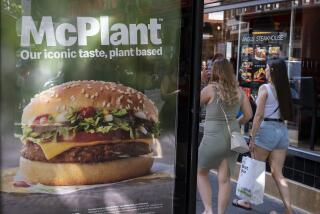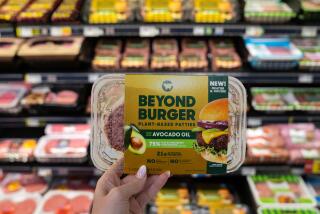Grass-fed beef: a small step in the green movement
- Share via
GRASS-FED beef is the hottest topic in boutique meat today, even though most people have never tasted it.
It represents a radical shift in livestock philosophy: For at least the last 50 years, most cattle have been raised on grass for the majority of their lives but then moved to a feedlot and switched to grain for the final couple of months. This finishing diet puts weight on quickly and results in the intramuscular fat, or marbling, that gives beef rich flavor and moist, tender texture. Grass-fed cattle stay in the pasture to the very end.
This is what gives the meat its distinctive tang. But flavor is not the only reason that grass-fed beef is so popular, or even necessarily the main one. Its promoters cite its “naturalness,” healthfulness and its ecological benefits.
Cattle are ruminants, and their digestive tracts are designed to digest grass rather than grain, grass-fed fans say. They also say it is more healthful -- lower in fat, higher in linoleic acid and omega-3 fatty acids. And, they say, because feedlots and grain farming consume fossil fuels, grass-fed beef is better for the environment.
The grass-fed scene is growing by leaps and bounds. The Web site www.eatwild.com includes a state-by-state listing of grass-fed beef producers that has grown from just 50 three years ago to more than 700 today. The site records more than 1,500 visits a day.
Although it is still a rarity in Southern California restaurants, Chez Panisse’s Alice Waters is so enthusiastic about the ecological benefits of the product that she wants to switch her menu to purely grass-fed beef.
Chef-forager Chris Lee, the point man on the project, says that while he has been able to find good small producers, he hasn’t yet found the magic combination of quality and sufficient supply to make that switch possible.
If he does, there will be another, even bigger decision to make. For the most part, California grass-fed beef is highly seasonal, available only in the early summer, before the green grass the cattle feed on turns to straw.
Still, Lee insists that as a restaurant devoted -- perhaps even obsessed -- with local, seasonal ingredients, having grass-fed beef at Chez Panisse for only a couple of months a year is no more of a problem than having fresh tomatoes only in summer.
“We haven’t gone that way completely yet because we haven’t found the quality of beef that we want,” he says. “But we are still looking, and if we find it, yes, we would use beef only as a seasonal ingredient.”
In fact, the biggest drawback to grass-fed beef right now is that there simply isn’t enough to go around.
“It’s an idea whose time has come, but the actual product still has not,” admits Eat Wild’s Jo Robinson.
“It’s going to be at least two years before we get enough supply in the pipeline to meet demand. And the way demand is growing, I think we’re going to be behind for a long time.”
Not if Ernest Phinney has anything to do with it. He is the general manager of Western Grasslands Beef, an organization of 14 California grass-feeders.
In business only two years, it is already supplying upscale markets and restaurants in the Bay Area including Boulevard, Acme Chophouse and Berkeley Bowl Marketplace. It has just added a distributor for Southern California and is in discussions with a major retail chain here, Phinney says.
At this point, the group is harvesting an average of 16 head a week -- fairly big by boutique standards, but a pittance in the world of supermarkets. Still, with several thousand cattle to draw from, Phinney says his group has plenty of room to grow.
More to Read
Eat your way across L.A.
Get our weekly Tasting Notes newsletter for reviews, news and more.
You may occasionally receive promotional content from the Los Angeles Times.











